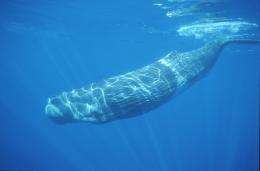March 16, 2011 weblog
Sperm whales have individual personalities

(PhysOrg.com) -- In a recent study published in Animal Behaviour by Dalhousie University biologists Hal Whitehead and Shane Gero, the concept that sperm whales (Physeter macrocephalus) are individuals is being learned.
Researchers have known for years that other cetacean species use vocalizations for communication, however they have only been studied in bottlenose dolphins and humpback whales, and even that research is still in its infancy.
Because sperm whales usually travel in large groups and over great areas, researchers have had difficulty studying and distinguishing their vocalizations. Researchers in the latest study were able to focus on a sperm whale family located in the waters around Dominique. These particular whales tend to stay in this local area enabled the researchers to conduct a long term study on their communication, as well as isolate individual whales and their distinct sounds.
These researchers studied the pattern of clicks, or "codas" (this is the technical name given to a distinctive series of clicks), that the whales use for communication. These high-frequency clicks are created by air that gets pushed through the skull of the whale. It is the difference in skull size between each whale that seems to create the different reverberation rates in the clicks, thus enabling researchers to distinguish which whales are making which sounds.
While the study of these codas is just beginning, researchers have discovered that they seem to fall into one of two different patterns, with the exception of the one mother whale within the group who had a separate set of vocalizations researchers believed to be a form of communication designed solely for the calf.
The first pattern that researchers have distinguished is that of two slow-paced and consecutive clicks, followed by three rapid clicks. This distinct pattern has only been reported within the groups of sperm whales in the Caribbean. The belief of the researchers is that this pattern may be used to identify a particular family, or group of sperm whales, letting the others know that they are part of the family.
The second pattern is heard from sperm whales all over the world and is composed of five regularly spaced clicks. It is this pattern that researchers believe could eventually point to way of individuality for each whale; in essence an individual name.
While this study is preliminary, it does show the possibility of these sperm whales having a more complex knowledge and understanding, as well as a method of real communication. In other studies we have seen the social behaviors that show more background n culture rather than instinct, so this continuing research may open the doors to a better understanding of these large animals. Researcher Shane Gero believes that the research is just beginning and their understanding of these whales and their communication is nowhere near complete, but that the assumption that these whales have a sense of self can be made.
More information:
Individually distinctive acoustic features in sperm whale codas, Animal Behaviour, by Ricardo Antunesa, Tyler Schulzb, Shane Gerob, Hal Whiteheadb, Jonathan Gordona and Luke Rendell, dx.doi.org/10.1016/j.anbehav.2010.12.019
via Wired
(c) 2011 PhysOrg.com















